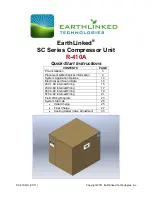
17
English
Checking Safety Valve
WARNING:
Hot surfaces. Risk of burn. Tubes, pump head, and
surrounding parts are very hot, do not touch (see the Hot Surfaces
identified in Fig. 1). Allow compressor to cool prior to servicing.
WARNING:
Risk of bursting. If the safety valve does not work
properly, over-pressurization may occur, causing air tank rupture
or an explosion.
WARNING:
Risk from flying objects. Always wear certified safety
equipment: ANSI Z87.1 eye protection (CAN/CSA Z94.3) with side
shields.
WARNING:
Risk from noise. Use ear
protection (ANSI S12.6 (S3.19) as air flow
noise is loud when draining.
Before starting compressor, pull the ring on
the safety valve (G) to make sure that the
safety valve operates freely. If the valve is
stuck or does not operate smoothly, it must
be replaced with the same type of valve.
Checking Air Filter
WARNING:
Hot surfaces. Risk of burn. Tubes, pump head, and
surrounding parts are very hot, do not touch (see the Hot Surfaces
identified in Fig. 1). Allow compressor
to cool prior to servicing.
A dirty air filter will not allow the
compressor to operate at full
capacity. Keep the air filter clean at
all times.
1. Ensure Auto/Off switch (B) is
in the OFF (O) Position.
2. Allow unit to cool.
3. Unsnap the air filter cover
to remove (S).
4. Check the filter element (T). If it is dirty, blow compressed air
through the filter element for 10-15 seconds or replace
if needed. If the filter is filled with paint, replace it.
5. Place element into housing and reattach the air filter cover.
CAUTION:
Risk of unsafe operation. Do not operate without air
filter.
Draining Air Tank (Fig. 2)
WARNING:
Risk of unsafe operation. Air tanks contain high
pressure air. Keep face and other body parts away from outlet of
drain. Use eye protection [ANSI Z87.1 (CAN/CSA Z94.3)] when
draining as debris can be kicked up into face.
WARNING:
Risk from noise. Use ear protection (ANSI S12.6
(S3.19) as air flow noise is loud when draining.
NOTE:
All compressed air systems generate condensation that accu-
mulates in any drain point (e.g., tanks, filter, aftercoolers, dryers). This
condensate contains lubricating oil and/or substances which may be
regulated and must be disposed of in accordance with local, state,
and federal laws and regulations.
1. Set the Auto/Off switch to “OFF (O)”.
2. Turn the regulator knob counterclockwise to set the outlet
pressure to zero.
3. Remove the air tool or accessory.
4. Pull ring on safety valve allowing air to bleed from the tank until
tank pressure is approximately 20 PSI. Release safety valve
ring.
5. Drain water from air tank by opening drain valve on bottom of
tank.
G
S
T
















































